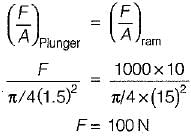Test: Energy Transfer - 2 - Mechanical Engineering MCQ
10 Questions MCQ Test - Test: Energy Transfer - 2
The condition when the speed of the driving and driven shafts are the same in hydraulic coupling is known as
Consider the following statements pertaining to fluid coupling:
1. Low viscosity fluids are preferred.
2. Increasing the density of fluid increases torque transmission at a given speed.
3. Fluid coupling are widely used in Automobiles, Aviation and Marine machinery.
Which of the above statements are valid?
1. Low viscosity fluids are preferred.
2. Increasing the density of fluid increases torque transmission at a given speed.
3. Fluid coupling are widely used in Automobiles, Aviation and Marine machinery.
Which of the above statements are valid?
Which of the following parts act as a reaction member and positioned in the middle of flow from the impeller and the runner in a torque converter
A hydraulic system is a circuit in which power and forces are transmitted through a liquid. These can be classified in to hydrostatic system and hydrodynamic system. Which of the following is not an example of hydrostatic system?
By which one of the following, a small quantity of water may be lifted to a great height
A hydraulic press has a ram of 15 cm diameter and plunger of 1.5 cm. it is required to lift a mass of 1000 kg. The force required on plunger is nearly equal to




















